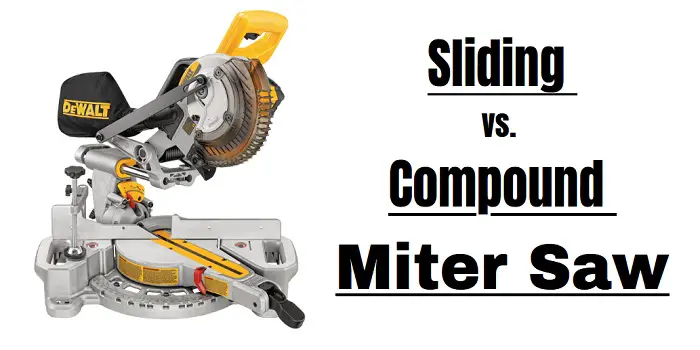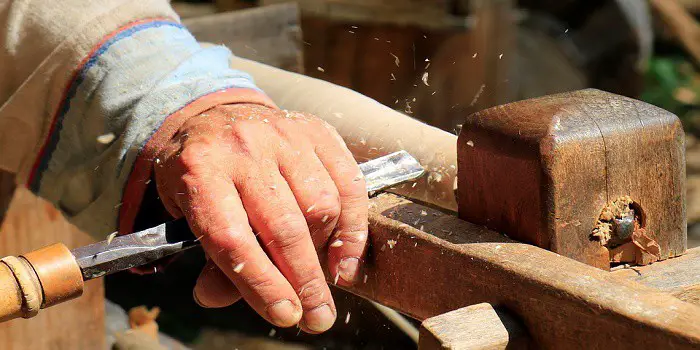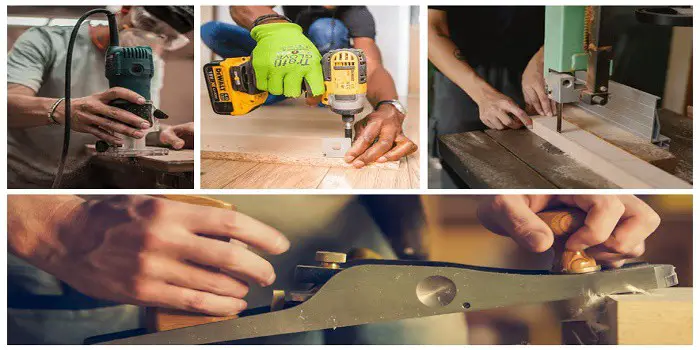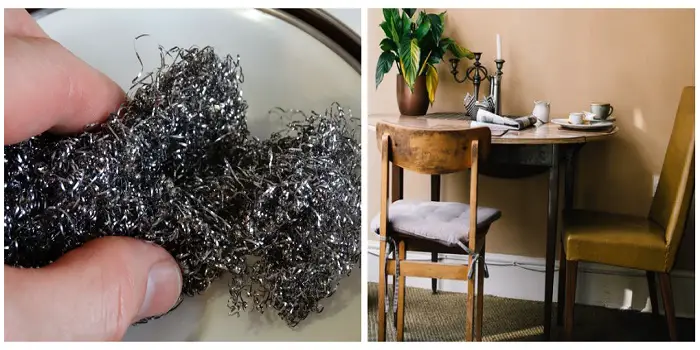
There are three basic types of miter saws, standard, sliding, and compound.
While the standard version lets you make angled or mitered cuts into the material, the compound miter saw also lets you create bevels.
The sliding miter saw allows the blade to slide out and will enable you to cut wider boards.
Depending on the model you choose, some versions allow you to change the angle of the cut one degree at a time.
Although most versions have pre-set angles such as 45, 30, and 15 degrees.
Once the angle is set, the circular blade is pulled down into the material to create a smooth, clean cut.
In terms of which one is better, the sliding miter saw offers distinct advantages over the compound version. However, that is not to say the compound miter saw should not be considered.
What follows is a breakdown of the sliding and compound miter saws so you can make the best-informed decision about which one is for you.
What is a Sliding Miter Saw?
A sliding miter saw is essentially a compound miter saw that lets you make both miter and bevel cuts into the material.
The difference is that since the blade can slide out, this saw lets you cut wider materials than the compound miter saw.
The blade can not only slide, but the saw has rails that allow you to move the saw forwards or backward depending on your needs.
Overall, you have a greater cutting capacity with the sliding miter saw.
Sliding Miter Saw Pros & Cons
The biggest advantage of a sliding miter saw is that it can cut wide material without having to reposition parts of the saw.
For those who are cutting miters and bevels into materials of different widths, the sliding miter saw is the one for you.
However, you will need considerably more space to operate the sliding miter saw when working with wide pieces of material.
In addition, the movement of the blade means that you will need more room to work even if the material is relatively small.
Another issue is the expense, as sliding miter saws can be expensive.
If your profession includes working with different widths of material, then purchasing the saw is certainly worth the expense.
However, you should evaluate what you want before making that decision. In some cases, the sliding miter saw may not be necessary.
What is a Compound Miter Saw?
This type of miter saw does more than simply cut angles; you can cut bevels as well.
The difference between a compound and a standard miter saw is the compound version mounts the blade on a pivoting arm that can be tilted to different angles.
Because of this feature, you can make bevel cuts easily.
The versatility of the compound miter saw is considerable over the standard version, which is why many choose the compound because it can make a greater variety of cuts.
But what is the difference between a miter and a bevel cut?
A miter cut creates angles that usually are used to join two pieces of material together.
Imagine the 90-degree angles on a picture frame.
They consist of four pieces of wood cut at 45-degree angles on the corners to make the frame itself.
While a miter cut goes across the face of the material, the bevel cut will go through the thickness of the material.
Instead of the horizontal plane, which is a miter cut, the bevel cut operates on the vertical plane.
Bevel cuts are typically used for crown molding or any material in which an angled cut is needed on both the vertical and horizontal plane.
While most compound miter saws tile the blade in one direction, either left or right, there is the dual compound miter saw that allows for both angles.
This means that you do not have to turn the material around to make the opposing cut.
This helps reduce work time in cutting angles but may not be necessary depending on how much work you need to accomplish.
Compound Miter Saw Pros & Cons
The greater cutting arc of the compound miter saw offers a considerable advantage over the standard and sliding versions.
Because no rails are present, a compound miter saw can cut material considerably thicker than a sliding miter saw when using the same size blade.
For those who work with materials with varying thicknesses, a compound miter saw may be the perfect answer.
In addition, you need less room to use a compound miter saw.
It also helps that they are less expensive compared to a sliding version.
The compound miter saw is a good solution for those with less room or on a tight budget.
The downside is if you work with wider pieces of material – a sliding version is simply superior and maybe the only one to use in such cases.
Sliding vs. Compound: Which One is Better?
The best miter saw (sliding or non-sliding) will depend on your needs.
The sliding miter saw will be superior if you work with wider materials, such as sheets of wood.
However, if you hardly ever need to make angled or bevel cuts into wide pieces of material, then the compound miter saw is better suited for your needs.
Similarly, a compound miter saw is perfect if you are creating picture frames, moldings, or baseboards. But, if you are cutting material 8” wide or wider, you should consider a sliding miter saw.
Space
The space you have is another consideration, as a sliding miter saw tends to be larger and heavier and needs more room to work.
For smaller workshops, the compound version may be your only choice. This is especially true if you have limited space in your garage or workshop.
If you can set up a sliding miter saw in one place and leave it, that may be your best option. However, if you do not have the room or do not want to move the sliding miter saw around, then a compound miter saw may be better.
Weight
The weight of the saws is also something to be considered as well.
A compound miter saw is easier to move around, making it well-suited for taking to a job site. In contrast, a sliding miter saw is heavier and really should be kept in one place.
However, you can purchase a miter saw stand that provides enough support to make your sliding version more portable.
In general, if you are looking for portability and the material is mostly less than 8” wide, then a cordless compound miter saw may be perfect.
But if you are working with wide materials, consider investing in a miter saw stand to provide better stability for your sliding version.
Of course, this will mean having a large enough vehicle to carry the saw and the stand. But it will be worth it if that is your job.
Cord vs. Cordless
Another consideration is whether to go corded or cordless.
For compound miter saws that will be taken to a job site, you may want to consider a cordless version and have backup batteries along with a charger so you can work all day.
If you do a lot of mitering work, it will also come down to the width of the material.
- If it is 8” or less, then a compound miter saw is the answer
- If it is typically more than 8”, then a sliding miter saw is the right choice
So, decide to buy a cord or cordless machine based on this.
Your Budget
Another consideration is your budget. A sliding miter saw is considerably more expensive compared to a compound version.
A solid 10” compound miter saw can be found for under $200, while a top-of-the-line 12” sliding saw may reach $500 or more.
But you can make the decision easier by focusing on two aspects, blade size and whether to choose a slider.
Final thoughts
The miter saw is one versatile tool. But the versatility makes it more challenging to make the right purchase.
A lot needs to be considered from the different versions, such as standard, compound, sliding, single bevel, and dual bevel.
Plus, you will need to consider: whether you need to purchase a 10” or 12” blade, how much room you have in your workshop, and how much money is in your wallet.
It all comes down to your needs. What you need will determine what you should purchase.
It does not make sense to spend money on something you may never use, so consider everything before choosing between a compound or a sliding miter saw.
Share the post "Sliding vs. Compound Miter Saw: What’s Better for My Project?"

Hi, I am Mark Garner a professional carpenter, woodworker, and DIY painter. I live in the small city of Peoria, Arizona as a semi-retired woodworker. I have started this blog with a simple motive to help you with my wood experience in this sector. If you like to know more about what I love doing and how it all got started, you can check more about me here.





